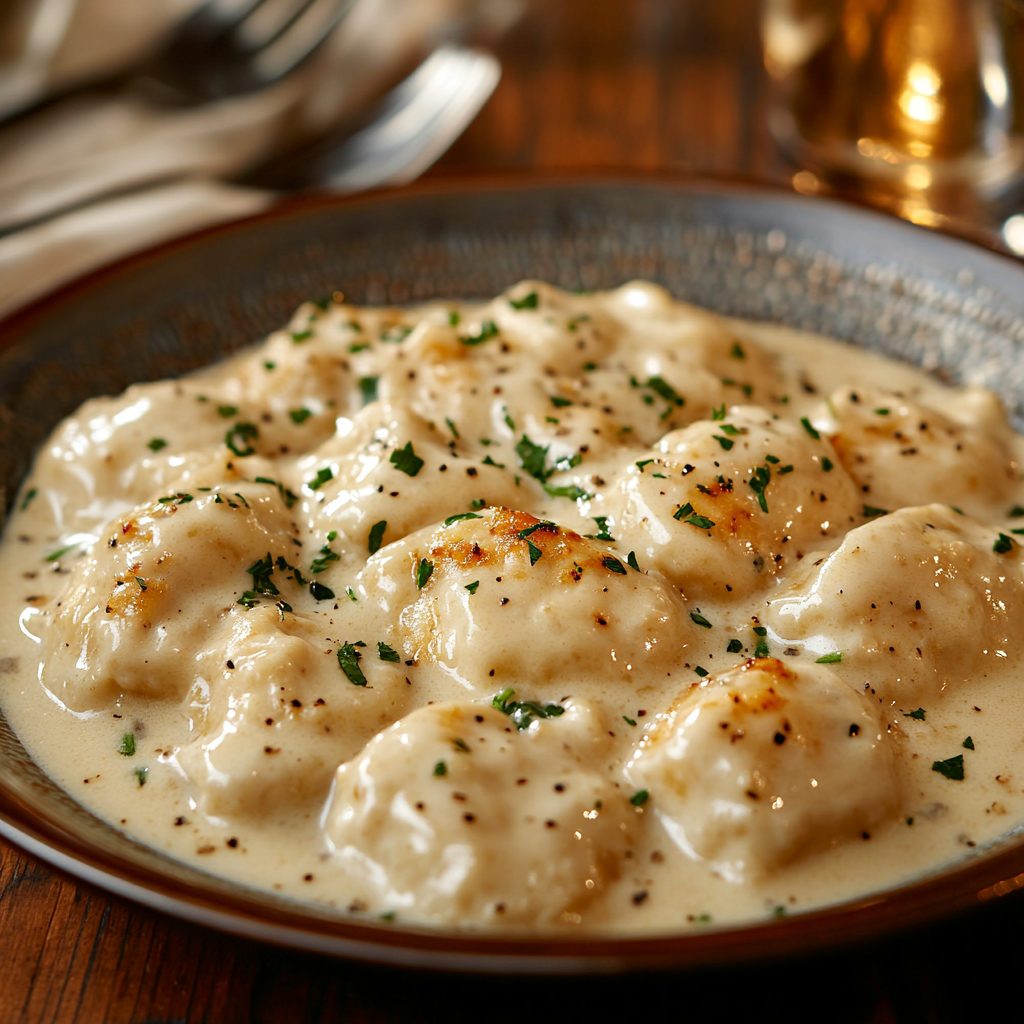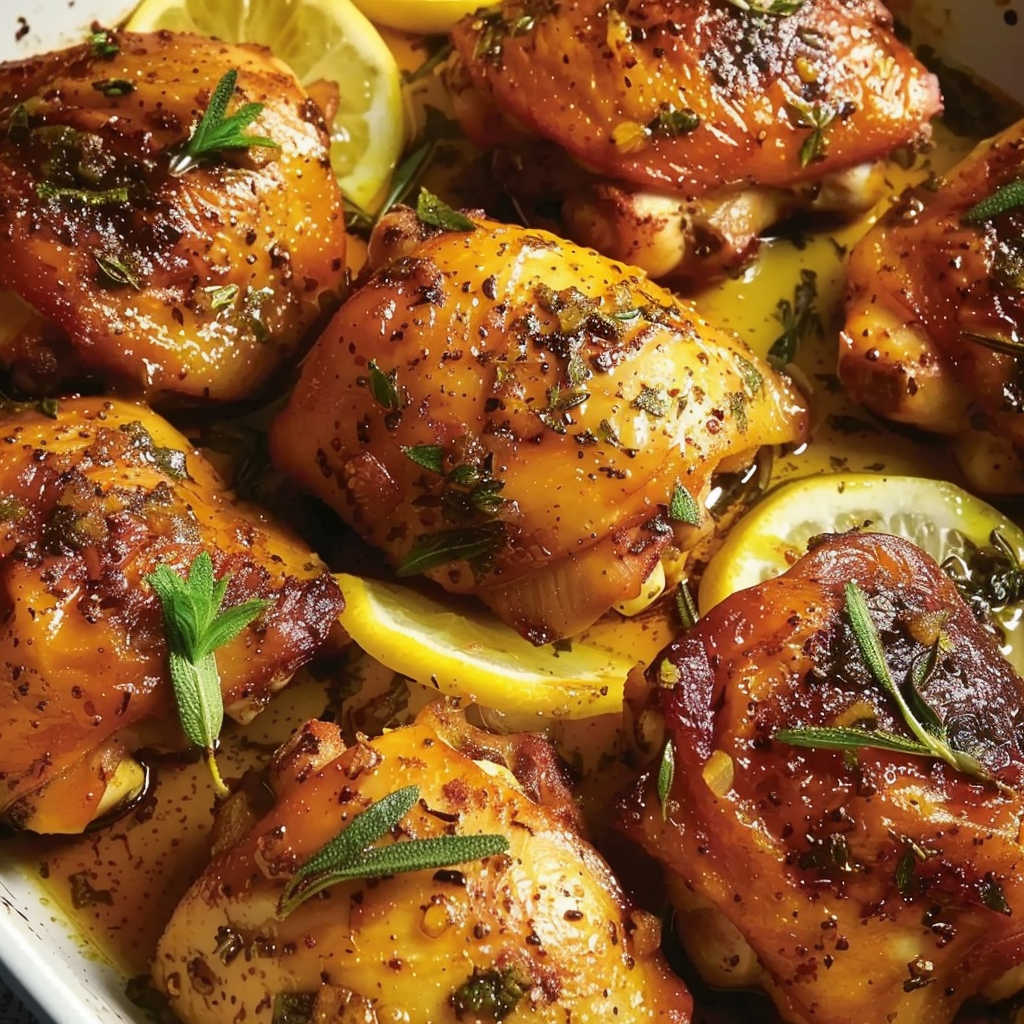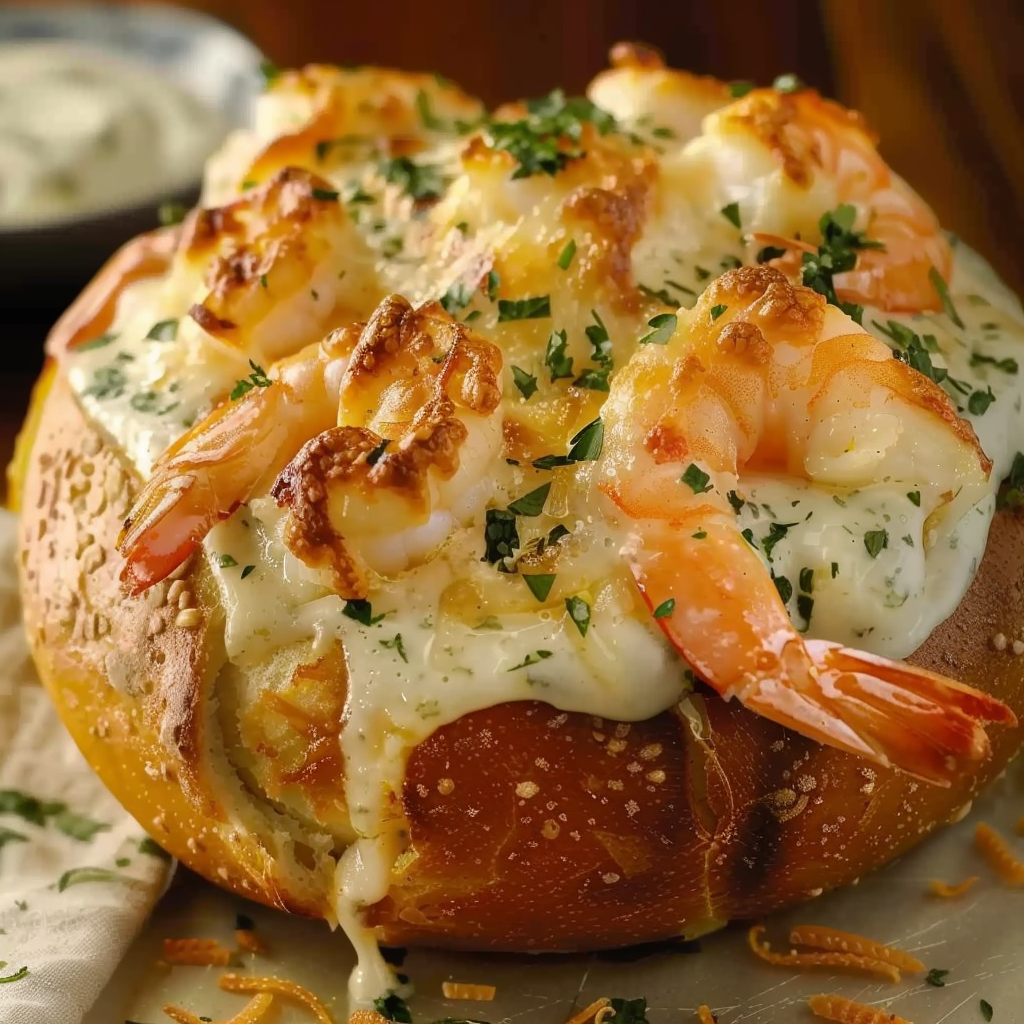Cracker Barrel’s Chicken and Dumplings is one of the restaurant’s most beloved comfort dishes, known for its Southern charm and home-cooked appeal. Cracker Barrel was founded in 1969 in Lebanon, Tennessee, and its menu reflects classic Southern recipes passed down through generations. Chicken and dumplings, with its tender chicken, fluffy dumplings, and savory broth, embodies the essence of traditional comfort food, offering a taste of home for many diners.
The dish has become iconic due to its hearty, wholesome nature, offering a filling, satisfying meal for people of all ages. The appeal lies in its simplicity, combining basic ingredients into something incredibly flavorful. It’s a dish that feels like it’s been cooked slowly with care, yet it’s surprisingly easy to make. Whether you’re dining at Cracker Barrel or preparing it in your own kitchen, chicken and dumplings delivers a sense of warmth and nostalgia with every bite.
Why Make Homemade Chicken and Dumplings?
Making Cracker Barrel’s Chicken and Dumplings at home allows you to bring the restaurant’s iconic flavors to your own kitchen while offering a few advantages. First, it’s cost-effective—using simple, affordable ingredients like chicken, flour, and broth makes it budget-friendly. Plus, homemade versions are customizable to your tastes, whether you prefer adding extra herbs or vegetables for a more personalized dish.
In comparison to dining out, making this meal at home provides control over ingredients, ideal for those with dietary preferences or restrictions. You can also tweak the recipe to suit your family’s needs, creating a rich, flavorful meal that feels like it’s been passed down through generations. The process itself, from rolling out the dumplings to simmering the broth, can be a comforting activity, perfect for sharing with loved ones. Ultimately, homemade chicken and dumplings becomes more than just a meal—it’s a way to create lasting memories around the dinner table.
Ingredients Breakdown and Preparation
Ingredient Breakdown
For the Broth
- Chicken broth: The broth is the heart of this dish, serving as the base that ties everything together. Whether homemade or store-bought, the chicken broth provides a rich, savory flavor that defines the dish. Opting for low-sodium broth allows you to control the salt content.
- Celery & onion: These aromatic vegetables are simmered in the broth to enhance its natural flavor. The mild sweetness of the onion and the subtle, earthy flavor of celery create a more well-rounded taste, complementing the chicken and dumplings perfectly.
- Chicken breasts: Boneless, skinless chicken breasts are ideal for simplicity and ease. They cook quickly and can be easily shredded, delivering tender bites of chicken throughout the dish. Chicken thighs can be used for a richer flavor, but breasts keep the dish lighter.
For the Dumplings
- Flour, baking powder, and salt: These are the foundation of the dumplings. All-purpose flour is standard, while baking powder helps the dumplings rise slightly, giving them a light, fluffy texture. Salt balances the flavors and ensures the dumplings don’t taste bland.
- Milk: Milk is added to bring the dry ingredients together, forming a smooth dough that can be rolled out and cut. The fat in milk adds richness to the dumplings, contributing to their tenderness. Full-fat milk is often preferred for a creamier texture, but low-fat alternatives work too.
Optional Ingredients for Flavor Enhancement
Fresh herbs
- Parsley and thyme: These herbs can be used as garnish to enhance both the flavor and visual appeal of the dish. Parsley adds a bright, fresh note, while thyme contributes an earthy, slightly lemony undertone that complements the richness of the broth. Fresh herbs also bring a pop of color, making the dish look more appetizing when served.
Butter
- Butter can be stirred into the broth at the end of cooking to enrich the flavor and create a creamier mouthfeel. The addition of just a couple of tablespoons makes a significant difference, adding a velvety finish to the broth and making the dish even more indulgent. This is a great option if you want to elevate the dish without much effort.
Additional suggestions
- Carrots: Adding diced carrots to the broth while it simmers can bring a touch of sweetness and extra texture to the dish. The carrots soften as they cook, integrating well into the dish.
- Garlic: For those who enjoy a bit more depth, a few cloves of minced garlic can be sautéed with the onion and celery to enhance the savory profile of the broth. Garlic brings warmth and a slight pungency that complements the chicken and dumplings well.
Step-by-Step Cooking Guide
1. Preparing the Broth
The broth serves as the foundation of this dish, and its quality directly affects the flavor of your chicken and dumplings. Begin by placing the chicken broth, halved celery stalks, and onion into a large stockpot or Dutch oven. Bring the mixture to a simmer over medium heat, allowing the vegetables to release their flavors into the broth. The slow simmering process enhances the flavor by gently extracting the savory notes of the chicken and vegetables, creating a rich, aromatic base for your dish.
Once the broth is simmering, add the boneless, skinless chicken breasts. Let the chicken cook gently for about 15 minutes or until it reaches an internal temperature of 165°F. Cooking the chicken slowly prevents it from becoming tough, ensuring tender, juicy meat. Once cooked, remove the chicken from the broth and allow it to cool slightly before shredding it into bite-sized pieces. This step is crucial, as shredding hot chicken can result in uneven pieces.
If you’re short on time, you can substitute store-bought rotisserie chicken for a quicker alternative. Simply skip the chicken-cooking step, and add the pre-shredded chicken to the broth just before serving.
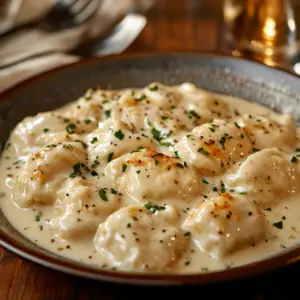
2. Making the Dumplings
While the chicken is cooling, you can prepare the dumpling dough. In a large mixing bowl, combine 3 cups of all-purpose flour, 1 tablespoon of baking powder, and 1 teaspoon of salt. Slowly pour in 1 cup plus 2 tablespoons of milk, stirring until a soft dough forms. Avoid overmixing, as this can make the dumplings tough instead of tender.
Next, lightly flour your work surface and roll the dough out to about ¼ inch thick. Rolling the dough too thick can result in dense dumplings, while too thin may cause them to fall apart during cooking. Aim for even thickness to ensure consistent cooking. Using a sharp knife or pizza cutter, slice the dough into squares about 1 to 2 inches wide. Try to cut the dumplings uniformly for even cooking and a balanced texture.
3. Cooking the Dumplings
Once your dumplings are prepared, it’s time to cook them in the simmering broth. Ensure the broth is at a gentle simmer—too vigorous a boil can cause the dumplings to break apart. Start adding the dumplings one by one into the broth, stirring gently as you go to ensure they don’t stick together. Cover the pot with a lid and allow the dumplings to cook for 15 minutes. Stir occasionally but carefully to avoid breaking the dumplings, which can happen if they are stirred too vigorously or too often.
Proper heat control is key here. Maintaining a gentle simmer prevents the dumplings from becoming mushy on the outside while ensuring they cook through to a light, fluffy texture on the inside. If the heat is too high, the dumplings may break down, while too low of a heat may leave them undercooked.
After 15 minutes, check the dumplings by cutting one in half to ensure it’s fully cooked inside. The dumplings should be soft and pillowy but hold their shape. Once the dumplings are cooked, return the shredded chicken to the pot, stir to combine, and let everything heat through for a few minutes. Taste the broth and adjust seasoning with additional salt and pepper as needed.
Putting It All Together
1. Adding the Chicken and Final Seasoning
Once the dumplings are fully cooked, it’s time to bring everything together. Carefully return the shredded chicken to the pot with the dumplings. Stir gently to ensure the chicken is evenly distributed throughout the broth and dumplings, being mindful not to break the dumplings. Allow the chicken to warm through for about 2-3 minutes.
At this stage, taste the broth and adjust the seasoning as needed. Because chicken broth and dumplings can absorb a lot of the initial seasoning, you may need to add more salt and pepper. Taste testing is important—add salt gradually to avoid over-seasoning. If you used a low-sodium broth or made your own, this step becomes even more crucial for balancing flavors.
Once you’re satisfied with the seasoning and the dish is heated through, it’s ready for any optional finishing touches.
2. Optional Final Touches
For an extra touch of richness, consider stirring in 2 tablespoons of butter just before serving. The butter adds a velvety smoothness to the broth, making it feel even more indulgent and comforting. Let it melt into the broth, giving the dish a luxurious finish without overpowering the other flavors.
Fresh herbs such as parsley or thyme can also be added as a garnish to brighten the dish. Parsley adds a pop of green and freshness, while thyme brings an earthy, aromatic note that balances the richness of the dumplings and chicken. Both herbs add aesthetic appeal and a slight herbal lift.
For presentation, serve the dish in a deep bowl to showcase the hearty broth and dumplings. Garnish each bowl with a sprig of fresh herbs and a light dusting of black pepper to give it a homemade yet elegant appearance. This final touch makes the dish even more inviting and ready to enjoy.
Tips and Tricks for Perfect Chicken and Dumplings
Ensuring Tender Chicken Every Time
To ensure tender, juicy chicken breasts, it’s important to cook them gently. Simmering chicken at medium heat rather than boiling it prevents the meat from drying out and becoming tough. Cook until the chicken reaches an internal temperature of 165°F and then remove it from the broth promptly. Letting the chicken rest for a few minutes before shredding allows the juices to redistribute, resulting in more tender meat.
If you want an even richer flavor, consider using bone-in chicken breasts or thighs. Chicken thighs are naturally more flavorful and have a higher fat content, making them juicier and more forgiving if cooked slightly longer. Thighs add depth to the dish, complementing the creamy broth and fluffy dumplings.
Dumpling Tips for Beginners
The key to perfect dumplings lies in the dough consistency. You want the dough to be soft and pliable, but not sticky. If the dough feels too dry, add a tablespoon of milk at a time to achieve the right texture. Conversely, if it’s too sticky, dust it with a little extra flour as you roll it out.
One of the most common mistakes is overworking the dough, which can lead to dense, tough dumplings. Once the ingredients are combined, mix the dough just until it comes together—over-kneading will activate the gluten in the flour, which makes the dumplings chewy. Handle the dough gently when rolling and cutting to preserve its soft, tender texture during cooking.
Variations and Customizations
Classic Variations
For a Southern-style version of chicken and dumplings, the broth is often thicker, resembling a creamy gravy. To achieve this, you can mix 2 tablespoons of flour or cornstarch with water to form a slurry, and then stir it into the broth before adding the dumplings. This creates a richer, more substantial base that pairs well with chunkier, heartier dumplings.
Adding vegetables such as diced carrots, peas, or sliced mushrooms transforms the dish into a more complete meal. The vegetables not only add color and texture but also enhance the nutritional value. Carrots contribute sweetness, while peas and mushrooms offer earthy notes that complement the savory broth. These additions make the dish even more wholesome and satisfying.
Customizing for Dietary Preferences
To make gluten-free dumplings, simply swap out the all-purpose flour for a gluten-free flour blend. Ensure the blend contains a binding agent, like xanthan gum, to help the dumplings maintain their structure during cooking. This substitution allows those with gluten sensitivities to enjoy the dish without sacrificing taste or texture.
For a dairy-free version, you can easily replace the milk in the dumpling dough with almond milk, soy milk, or any other plant-based milk. Coconut milk can also be used if you prefer a richer flavor. Butter can be substituted with dairy-free alternatives like margarine or plant-based butter to maintain that creamy finish in the broth while keeping the dish completely dairy-free.
Frequently Asked Questions (FAQs)
1. Can I use pre-cooked chicken for this recipe?
Yes, using rotisserie chicken or leftover chicken is a great time-saver. Simply shred the pre-cooked chicken and add it to the broth after the dumplings are cooked. This allows the chicken to heat through without overcooking, making the dish faster to prepare without compromising on flavor.
2. What is the difference between chicken and dumplings and chicken soup?
Chicken and dumplings have a thicker, more stew-like consistency due to the addition of dumplings and a heartier broth. Traditional chicken soup has a thinner, more liquid broth with noodles or rice. The dumplings in this dish create a more substantial, comforting meal compared to the lighter feel of chicken soup.
3. Can I make dumplings in advance?
Yes, you can make dumpling dough ahead of time. After preparing the dough, cover it tightly with plastic wrap and store it in the fridge for up to 24 hours. When ready to cook, roll out the dough, cut into squares, and drop them into the simmering broth as usual.
4. How can I reheat leftovers without drying them out?
To reheat, gently warm the leftovers on the stove over low heat, adding a little extra broth or water to prevent the dish from becoming too thick. Avoid overheating, as this can make the dumplings tough. Stir gently to maintain the dumplings’ soft texture.
5. Can this dish be made in a slow cooker?
Yes, you can make this dish in a slow cooker. Cook the chicken, broth, onion, and celery on low for 4-5 hours. Add the dumplings in the last 30 minutes of cooking. Make sure the slow cooker is on high to allow the dumplings to cook properly.
Conclusion and Serving Suggestions
Making homemade Cracker Barrel-style chicken and dumplings is a deeply satisfying experience that brings the comforting flavors of a classic Southern dish into your own kitchen. The process, from simmering the broth to creating soft, pillowy dumplings, offers a sense of nostalgia and warmth, perfect for sharing with family and friends. It’s a dish that’s both simple and heartwarming, providing a homemade touch that feels like a special occasion.
For serving, pair this hearty meal with sides like buttery cornbread or creamy mashed potatoes to complete the Southern comfort food experience. A side of green beans or a fresh salad can add some balance to the richness of the dish. Don’t hesitate to customize the recipe to your liking, whether by adding vegetables or adjusting the herbs. This recipe invites personalization, making it your own while keeping the spirit of Cracker Barrel’s timeless comfort food.
Print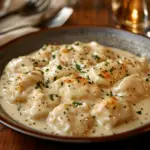
Cracker Barrel Chicken and Dumplings
Description
This recipe brings the comfort and nostalgia of Cracker Barrel’s famous Chicken and Dumplings to your home kitchen. Tender, shredded chicken is paired with fluffy dumplings in a rich, savory broth, creating a heartwarming dish that’s perfect for family meals, potlucks, or a cozy night in. Simple ingredients and a straightforward method make this a go-to recipe that anyone can master.
Ingredients
For the Broth:
- 6 cups chicken broth
- 2 celery ribs, halved
- 1 medium onion, halved
- 2 boneless, skinless chicken breasts (about 1 lb each)
- Salt and pepper to taste
For the Dumplings:
- 3 cups all-purpose flour
- 1 tablespoon baking powder
- 1 ¼ teaspoons salt (divided)
- 1 cup + 2 tablespoons milk
Optional Additions:
- Fresh herbs (parsley, thyme) for garnish
- 2 tablespoons butter for a richer broth
Instructions
Prepare the Broth:
- In a large stockpot or Dutch oven, bring the chicken broth, celery, and onion to a simmer over medium heat.
- Add the chicken breasts and cook until tender, about 15 minutes.
- Remove the chicken from the broth and let it cool slightly. Once cooled, shred the chicken into bite-sized pieces and set aside.
- Strain the broth, discarding the celery and onion, and return the liquid to the pot.
Prepare the Dumplings:
- In a large mixing bowl, combine the flour, baking powder, and 1 teaspoon of salt.
- Gradually stir in the milk until a soft dough forms. Be careful not to overmix.
- On a floured surface, roll the dough out to ¼ inch thickness. Cut into 1-2 inch squares.
Cook the Dumplings:
- Bring the broth to a gentle simmer. Add the dumplings one at a time, stirring occasionally to prevent sticking.
- Cover the pot and cook the dumplings for 15 minutes, stirring gently every few minutes.
Finish the Dish:
- Add the shredded chicken back into the pot with the dumplings and stir to combine.
- Taste and adjust the seasoning with salt and pepper as needed. For a richer flavor, stir in the butter.
- Garnish with fresh parsley or thyme before serving.
Serving Suggestions:
This dish pairs wonderfully with classic Southern sides like cornbread or creamy mashed potatoes. You can also serve it alongside green beans, a simple salad, or roasted vegetables to balance the meal.
Notes
- For a time-saving shortcut, use rotisserie or pre-cooked chicken instead of boiling fresh chicken breasts.
- For thicker broth, mix 2 tablespoons of flour or cornstarch with a little water and stir it into the simmering broth before adding the dumplings.
- Store leftovers in an airtight container in the refrigerator for up to 3 days. Reheat gently on the stove, adding a splash of broth or water to loosen the consistency if needed.


